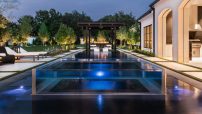
Rocio Escobar
Above: Pool design by Joan Roca, Imerzion Corp., Panama City; and George Moreno III, George Moreno & Partners, Panama Pacifico, Panama
Forgive me if I sound like a cheerleader for a minute, but the industry has come a long way in the past decade or so when it comes to design and construction.
We’ve seen it over the last several years in the level of design-award winners across the industry. Here, we’ve seen it as the caliber of entrants for our own Masters of Design program has increased. This year, we saw so many high-quality entrants that our judges had a tough time choosing our slate of winners.
As design education, trick features and unique materials have become more accessible, and pool/spa designers and builders as a category have raised their game, providing a feeling of luxury and elegance to even mid-range projects.
I’m not the only one who thinks so. I spoke with founders of the design education group Genesis, along with one of the organization’s instructors and Masters of Design judges to discuss the industry’s progress so far. They pointed to several industry improvements, some more obvious than others.
Signs of growth
Builders and designers have become more daring, and not only about features such as perimeter overflows and fire. Now they are venturing more into glass panels in pool walls and floors, says Genesis co-founder Brian Van Bower.
And a new word is starting to surface that, on its face, may not sound exciting, but definitely marks a new phase of sophistication: Restraint. Like their peers in architecture and landscape design, pool/spa designers are learning to avoid letting the bells and whistles or flashy materials take over, or for pools and spas to consume the space.
“Pre-recession, it was much more about the bells and whistles, the bling and the expensive extra features — the more features you could come up with, the better,” says Kate Wiseman, principal designer at San Diego-based Sage Outdoor Designs. “Lately there’s been a lot more of a modern sense of restraint, especially on high-end designs.”
A sure sign of mastery comes when someone can expertly go against commonly accepted rules. And we saw that in two of our Masters of Design winners this year, who scaled their pools larger than normal. But they did it knowingly and by employing certain strategies to make the projects feel comfortable.
But perhaps the biggest change has been the mindset of pool/spa designers and builders, says Wiseman, who is also a Genesis instructor and Masters of Design judge. “I think there have been pretty huge changes,” she says. “I don’t necessarily think the pool industry was thinking of themselves as designers [10 years ago]. There were a few people who functioned as designers and definitely thought of themselves that way. But it’s been a massive change since then. That change in self-image gets reflected in a change in marketing strategy and business focus, and all sorts of other things.”
This has likely contributed to that greater tolerance for risk to try new things.
All of this is becoming apparent to the outside world, says Genesis co-founder Skip Phillips. Other design industries, in particular, have become more open to working with pool professionals where, before, they may have delayed bringing pool professionals into a project.
“I think that we’ve generated some respect for our trades and disciplines,” Phillips says. “So we’re seeing that respect transferred now, until they’re taking a lot more interest in talking to qualified designers and builders from our industry.”
Where to now?
In life, there is always room for improvement. These experts agree that there is still a lot to be learned when it comes to the basics of design — subjects such as scale, line, texture, color theory.
“I think there are a few who are getting it, but unfortunately … contractors pick [popular and cutting edge] details and attempt to do them without any idea how they should fit into the boundary of the design,” Van Bower says. “I think we’ve got a long way to go in that regard.”
Through this regular column, I hope to help the industry elevate even higher by sharing ways for companies to fine-tune their techniques in both design and execution, from design issues such as combining materials and working in scale to the many execution and installation issues that can determine the success of the final product.


